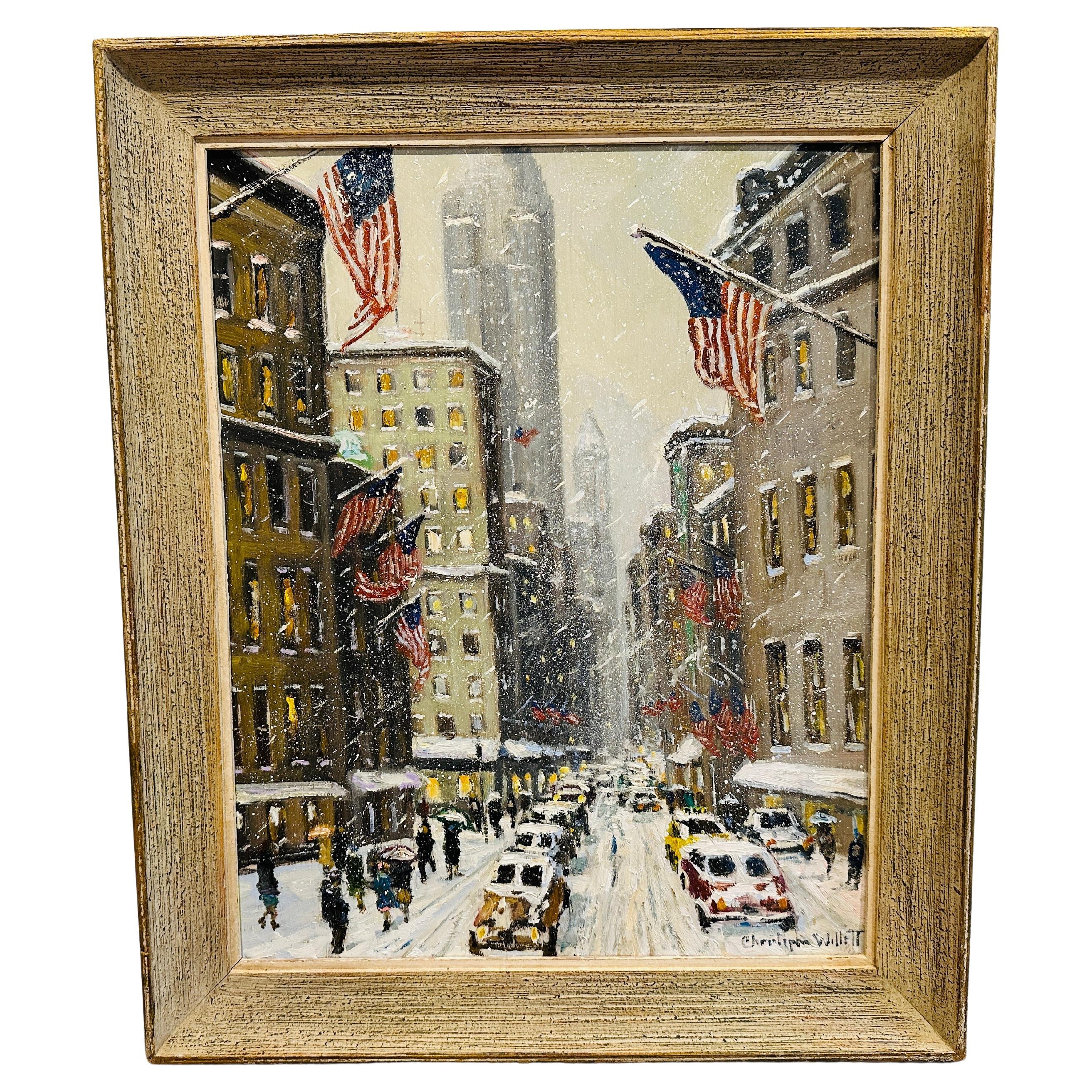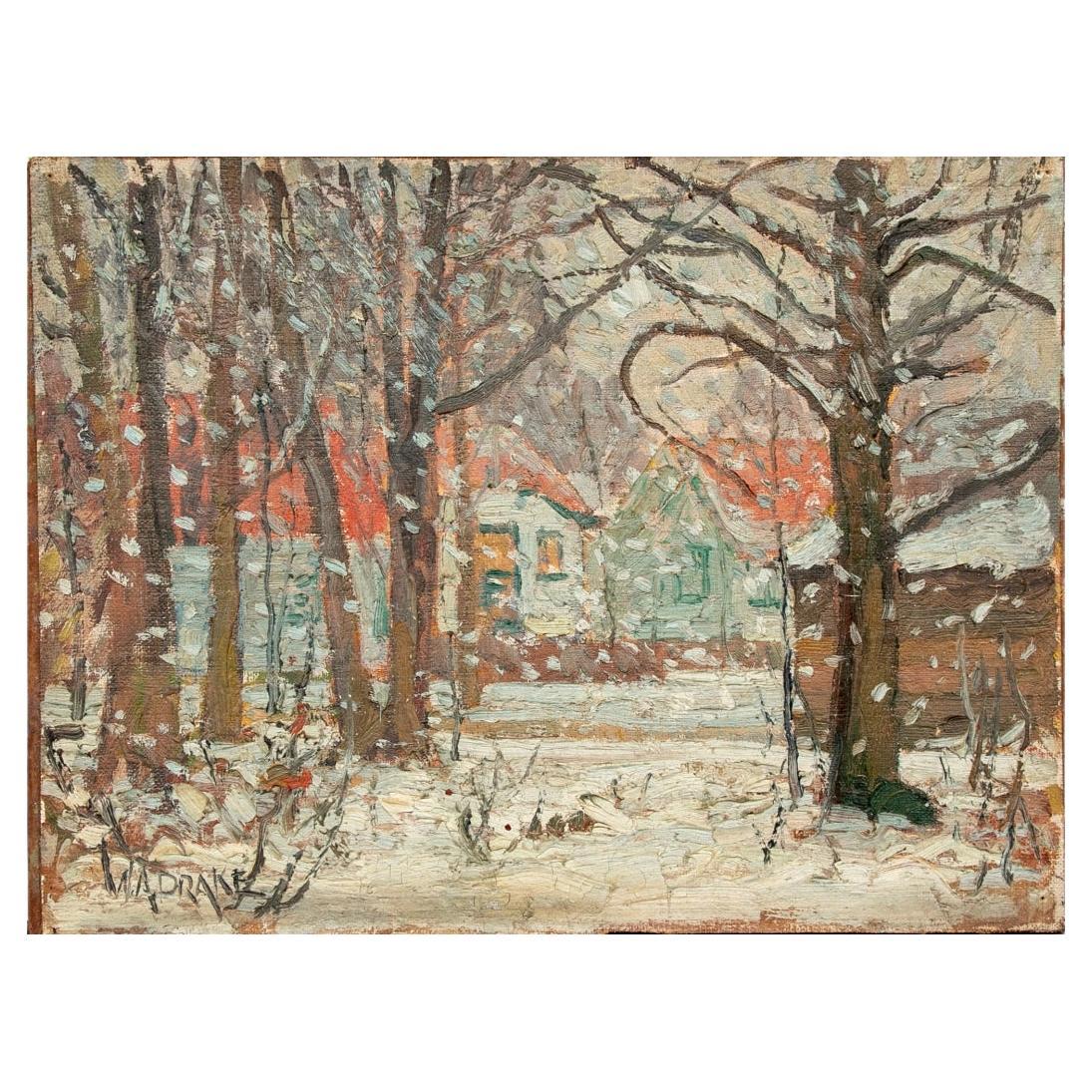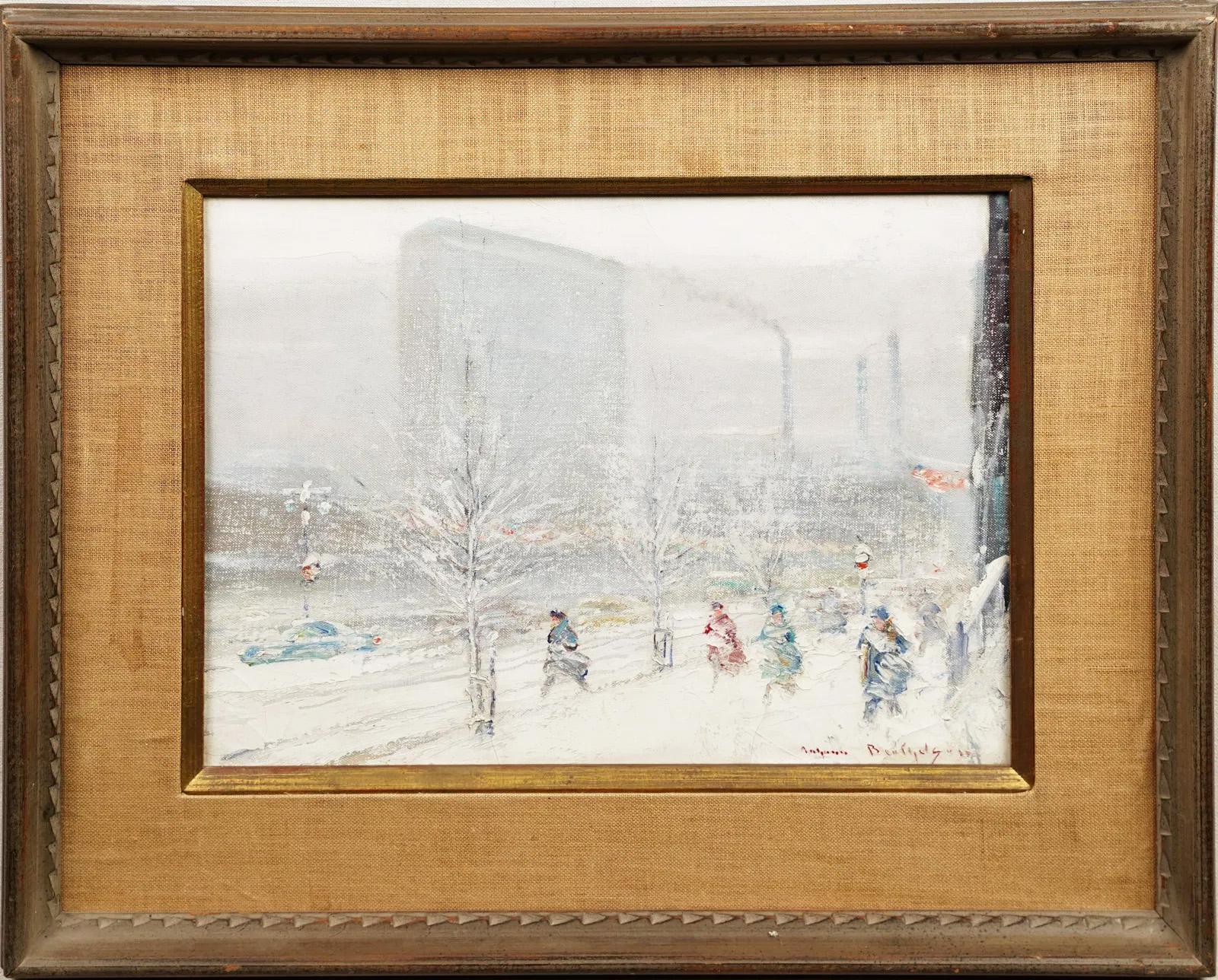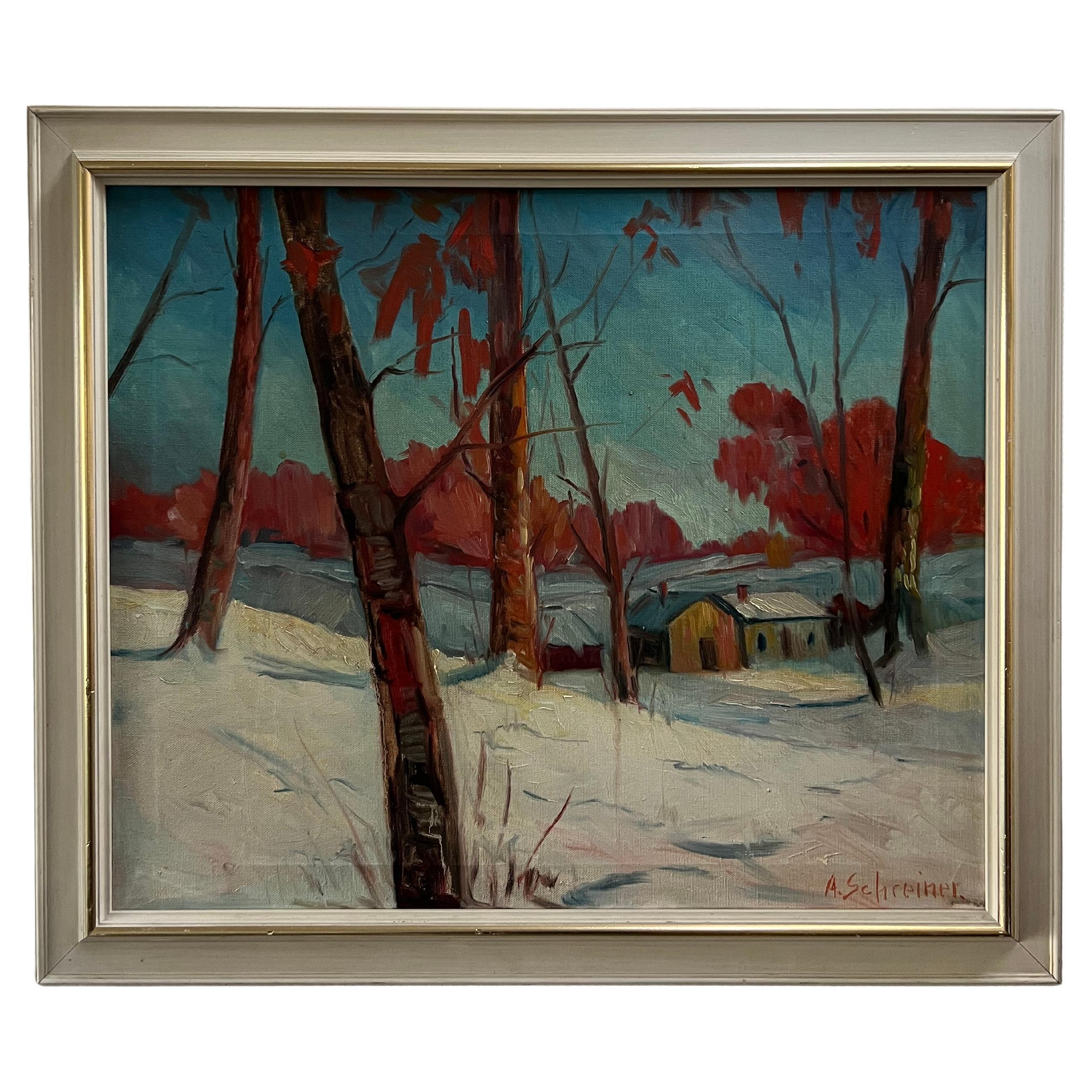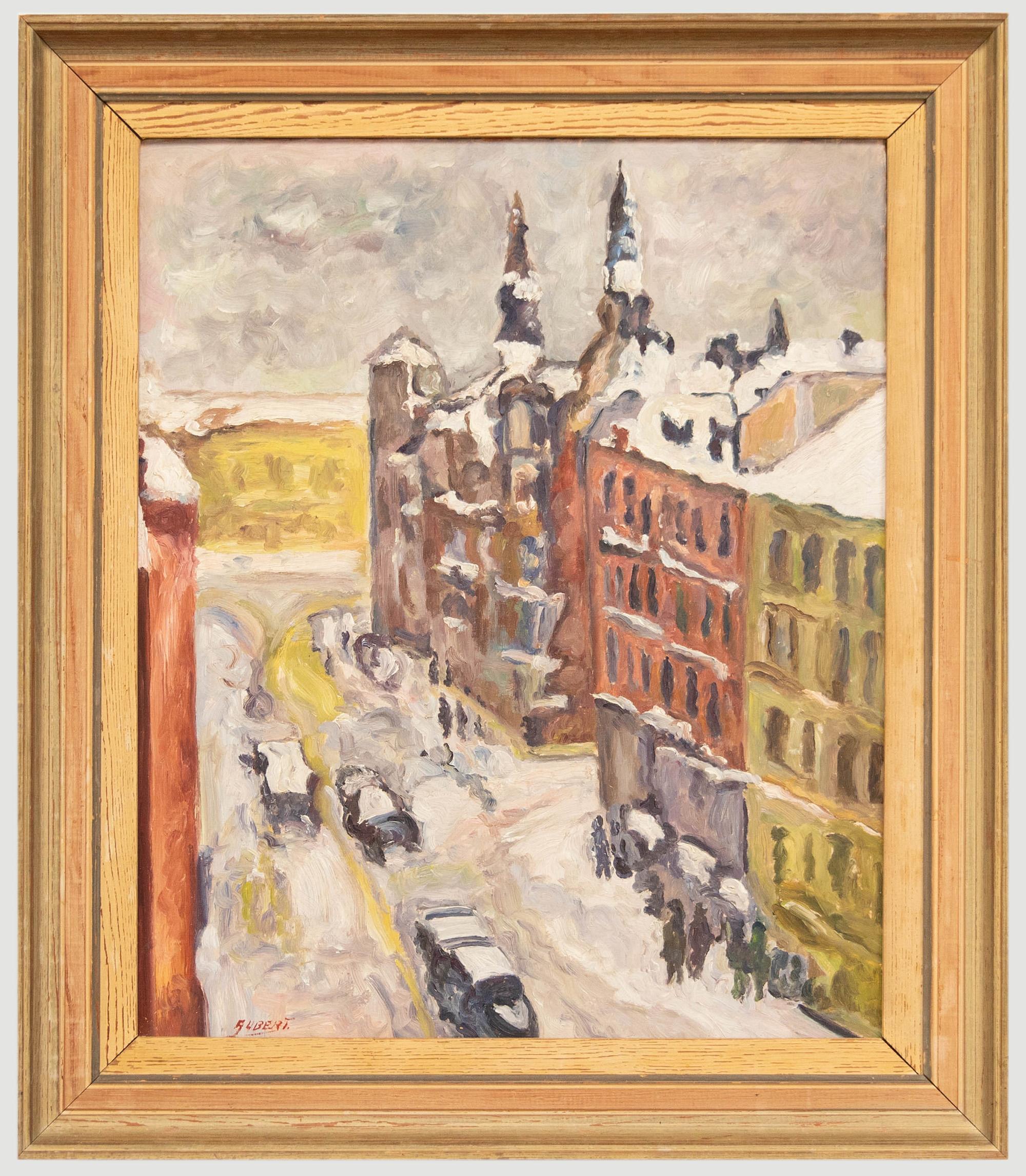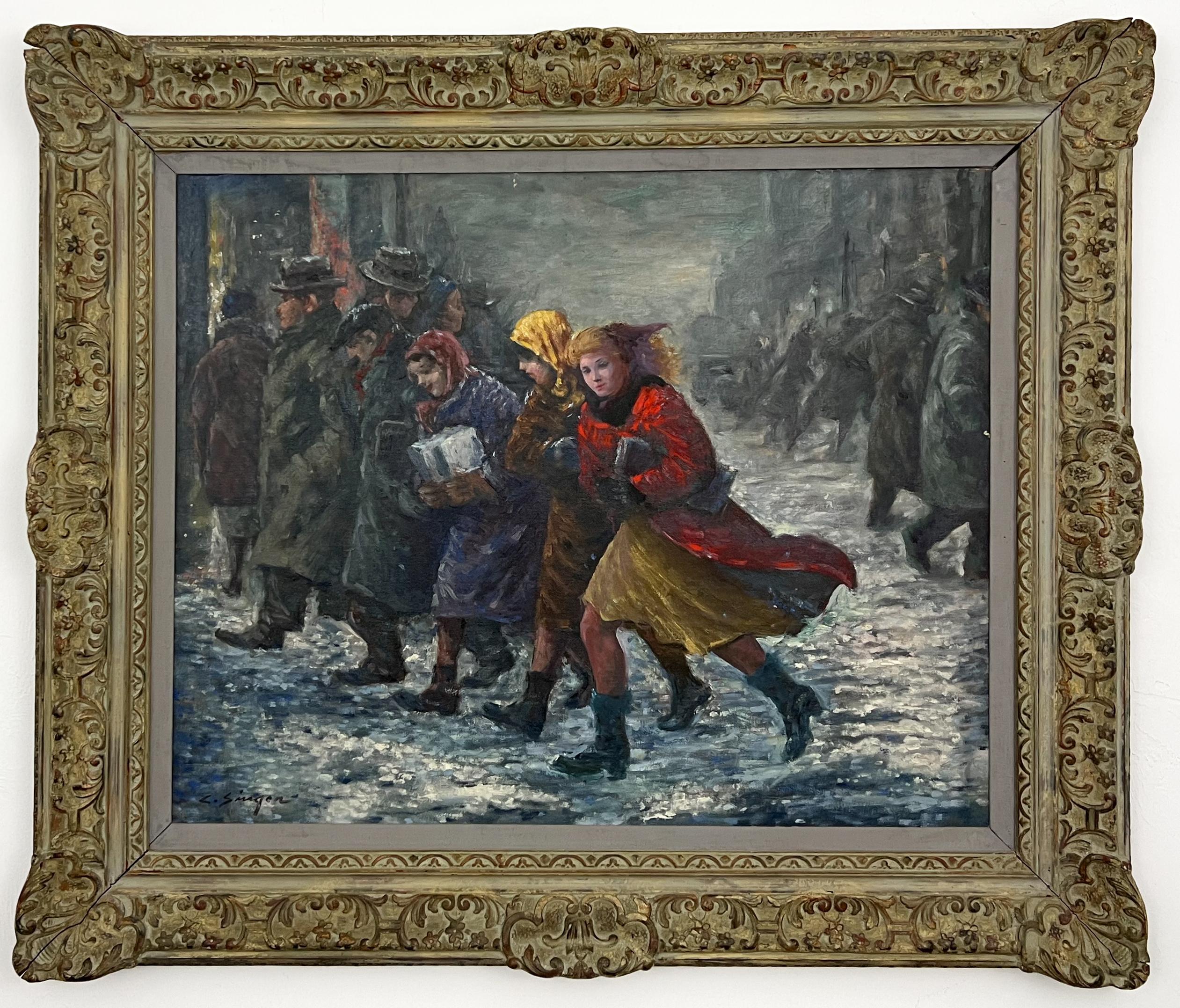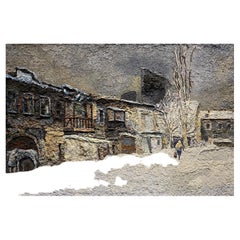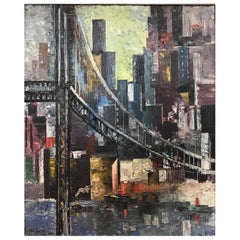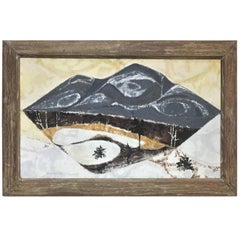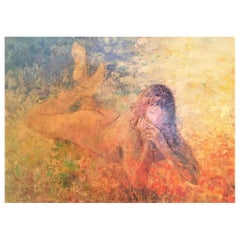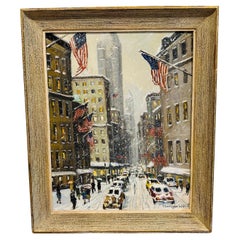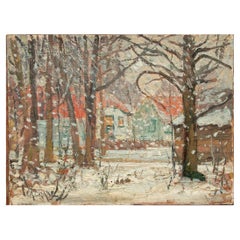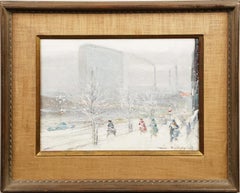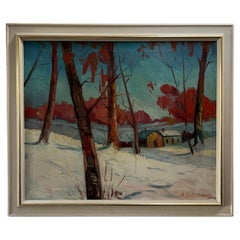Items Similar to Johann Berthelsen, Manhattan Snow Storm Scene, Oil on Canvas Painting, 1960s
Want more images or videos?
Request additional images or videos from the seller
1 of 11
Johann Berthelsen, Manhattan Snow Storm Scene, Oil on Canvas Painting, 1960s
$9,500
£7,212.24
€8,249.26
CA$13,272.88
A$14,762.34
CHF 7,708.43
MX$179,641.94
NOK 98,448.46
SEK 92,327.29
DKK 61,567.40
Shipping
Retrieving quote...The 1stDibs Promise:
Authenticity Guarantee,
Money-Back Guarantee,
24-Hour Cancellation
About the Item
This wonderful romantic painting depicts figures bustling along a Manhattan street during a snowstorm. Signed lower right.
Johann Henrik Carl Berthelsen (1883–1972)
Coming to America as a child, he enjoyed early success as an opera singer and music teacher. His friendship with the artist Wayman Adams resulted in a move to New York and experimentation with painting. When the great depression took a toll on his musical career, Berthelsen began selling oil scenes of his beloved New York City, which quickly found prominent buyers including William Randolph Hearst. While he also painted pastoral and mountain landscapes, Berthelsen’s snow scenes of Manhattan are particularly prized.
- Creator:Johann Henrik Carl Berthelsen (Painter)
- Dimensions:Height: 12 in (30.48 cm)Width: 16 in (40.64 cm)Depth: 1.5 in (3.81 cm)
- Style:Mid-Century Modern (Of the Period)
- Materials and Techniques:
- Place of Origin:
- Period:
- Date of Manufacture:1950s
- Condition:Wear consistent with age and use. MENTION PROMO CODE NIC-9 IN YOUR OFFER TO GET A 20%-DISCOUNT > OFFER IS VALID UNTIL MARCH 8, 2023. We make our best effort to provide a fair and descriptive condition report. Send us a message to request more details or discuss price.
- Seller Location:New York, NY
- Reference Number:1stDibs: LU2819313431702
About the Seller
5.0
Vetted Professional Seller
Every seller passes strict standards for authenticity and reliability
Established in 1993
1stDibs seller since 2017
83 sales on 1stDibs
Typical response time: 7 hours
- ShippingRetrieving quote...Shipping from: New York, NY
- Return Policy
Authenticity Guarantee
In the unlikely event there’s an issue with an item’s authenticity, contact us within 1 year for a full refund. DetailsMoney-Back Guarantee
If your item is not as described, is damaged in transit, or does not arrive, contact us within 7 days for a full refund. Details24-Hour Cancellation
You have a 24-hour grace period in which to reconsider your purchase, with no questions asked.Vetted Professional Sellers
Our world-class sellers must adhere to strict standards for service and quality, maintaining the integrity of our listings.Price-Match Guarantee
If you find that a seller listed the same item for a lower price elsewhere, we’ll match it.Trusted Global Delivery
Our best-in-class carrier network provides specialized shipping options worldwide, including custom delivery.More From This Seller
View AllLev Mezhberg, Urban Winter Landscape, Oil on Canvas Painting, 2003
By Lev Mezhberg
Located in New York, NY
Signed and dated in the bottom right corner “L.M.03”
Dimensions:
Height: 28 inches (70cm)
Width: 40 inches (100 cm)
Lev Leonidovich Mezhberg (Ukrainian/American, 1930-2007) was born and spent most of his life in the cosmopolitan city of Odessa, whose streets and suburbs are found in many of his works. In 1958, he graduated from Odessa College of Fine Art with highest honours. Mezhberg's work has been exhibited at museums and galleries throughout the Soviet Union, the USA and Europe and is owned by such collectors as leonard Bernstein, Vladimir Horowitz, Natalia Makarova...
Category
Early 2000s American Modern Paintings
Materials
Canvas
Sam Diamond, View of Manhattan, Oil on Canvas Painting, circa 1954
By Sam Diamond
Located in New York, NY
This is a double-sided painting -
Side 1: View of Manhattan, signed lower left and dated 1954.
Side 2 (reverse): Genre scene with porters.
Dimensions: Unframed: 20.5 x 30.5 inches Framed: 32 x 37 inches
Sam Diamond, Polish/American (1919 - 1978)
- Born May 1, 1919 in Warsaw, Poland.
- Family immigrated to the United States in November 1919.
- Began drawing at 6 years of age and continued an active interest in art throughout his school years.
- Graduated from Long Beach High School in 1936, at 16 years of age.
- Awarded a scholarship to Pratt Institute.
- Received art certificate from Pratt in 1939.
- Enlisted in U.S. Army Signal Corps. - Film Strip Division- doing artwork for training manuals from 1941-1946.
- Formed advertising art studio in 1946
- Continued painting and sculpture to present.
- Award for Sculpture and Painting, Westchester Art Society...
Category
Vintage 1950s American Mid-Century Modern Paintings
Materials
Paint
Sunshine, Original Upstate New York Landscape with Ashocan Reservoir
By Sunshine
Located in New York, NY
Sunshine was a known local artist in Woodstock and upstate New York area during 1960s. This abstract painting is of Ashocan Reservoir, located in Ulster County, New York. The reservo...
Category
Vintage 1960s American Mid-Century Modern Paintings
Materials
Acrylic
Bernard Taurelle, Nu, French Modernist Oil on Canvas Painting, circa 1960s
By Bernard Taurelle
Located in New York, NY
Signed lower right corner.
Stamped en verso Galerie Felix Vercel Paris - New York.
Original period frame.
Bernard Taurelle (French, B. 1931) is a famous French artist, widely known ...
Category
Vintage 1960s French Post-Modern Paintings
Materials
Canvas
Richard Wilt, Caesar, American Mid-Century Modern O/C Painting, Ca. 1960s
By Richard Wilt
Located in New York, NY
ABOUT ARTIST
Richard Wilt (American, 1915 - 1981) > Chronology and Exhibition History
1915 Born in Tyrone, PA
1981 Died in Ann Arbor, MI
EDUCATION:
1...
Category
Vintage 1960s American Mid-Century Modern Paintings
Materials
Canvas
Rolph Scarlett, Modernist Abstract Composition, Guache on Paper, Ca. 1950’s
By Rolph Scarlett
Located in New York, NY
Artist: Rolph Scarletti (Canadian, 1889 – 1984)
Object: Modernist Abstract Composition
Period: Ca. 1950’s
Medium: Guache on paper, framed
Dimensions (unframed):
Height: 9-1/3”
Width: 12”
Dimensions (framed):
Height: 22-3/4””
Width: 25-3/4”
Rolph Scarlett (Canadian, 1889 – 1984) was a consummate explorer of twentieth-century abstract painting. Never afraid of trying new styles, curious and opinionated, constantly engaged with the world around him while steadfastly aware that he was on his own path and his alone, Scarlett more than once proved to be at the artistic zeitgeist of the eras in which he lived. Exposed very early on to the work of Paul Klee through a chance meeting in Europe with the artist himself, Scarlett took up abstraction with a fervor that never diminished during his long and impressive career. To create something that had never existed before: this was Scarlett’s great cause. And that is what is most obvious when you look at Scarlett’s work—you have never seen anything quite like it.
Scarlett was Canadian-born, came of age in the Midwest, and spent few important years in Hollywood, where he designed stage sets. His work from this early period echoes Klee’s use of color, his confidence in naïve, primitive forms, and his blend of abstraction and figuration. In its flat spatial qualities it prefigures the Indian Space painting of the 1940s by a decade. He moved to New York in 1933 and eventually found his first great patron at the Museum of Non-Objective Painting, directed by Baroness Hilla Rebay and art patron Solomon R. Guggenheim. Guggenheim would collect over 60 works by Scarlett for his collection, more than any other artist outside of Vasily Kandinsky and Rudolf Bauer.
As a frequent exhibitor and lecturer at the Museum of Non-Objective Painting (MNOP), Scarlett honed his sensitive feel for bodies in space and capitalized on his trademark use of bright, vivacious colors into accomplished, perfectly harmonized geometric works. However, Scarlett soon morphed these hard-edged forms into a nuanced expressionistic abstraction which, at its best, seems to be populated by dancing forms that animate the canvases. Along this way he was advised by Rudolf Bauer, the German expatriate and one of the originators of non-objective painting in the teens. Bauer had the idea for the Museum, and Rebay, his champion, had found in Solomon Guggenheim a patron for manifesting it. When Bauer emigrated just before World War II, he wanted to meet Scarlett. The two became friends, and Bauer advised Scarlett on his work over the course of many years. Even in a 1979 interview, Scarlett began to tear up as he recalled his first meeting with Bauer, a man whose work he "worshipped," describing that, "It was a touching moment for me, I’ll tell you."
Scarlett and Rebay also had a close, important relationship, one in which he bore the brunt of her sometimes condescending, if motherly, critiques and admonitions with tolerance and gratefulness. Eventually, though, he had to push back. In a letter from 1951 he writes, "I have noticed with growing amazement that during the past three years you have accepted less and less of my work—and, that same work, which you rejected has been accepted and shown in the best and largest shows all over this country."
This period—the late 1940s to the early 1950s—did in fact correspond to Scarlett’s most critical success, and to a return to the fanciful forms and characters of his pre-war work. At the same time, he found his own rhythm and complexity using a drip style similar to, though denser and more opaque than, the one made famous by Jackson Pollock, who had worked for many years at the MNOP and with whom he shared common influences. In 1949 he had a very well received solo show in 1949 at the Jacques Seligmann Gallery, reviewed very favorably in The New York Times: "The impression made by these paintings is one of originality and strength." He was also included in a juried show "American Painting Today" at the Metropolitan Museum of Art in 1950 and in the Whitney Annual of 1951. The curator for the Whitney show in fact bypassed a selection of Scarlett’s careful geometrics in favor of a new "lyrical" drip painting—one which he describes as having had "a helluva good time" making.
Rebay articulated her loss of control over Scarlett very keenly in one of her last official letters to him: "So your way ended in the horrid jungle it is in now; even a Mr. Pollock’s smearage was not bad enough for you to have a try at; and betraying yourself, you betrayed art and my faith in you, and my present disgrace by my failure to foresee such an outrageous possibility—since you even paint objectively now."
Yet, despite the fact that he was moving in his own direction when the change in leadership took place at the Museum of Non-Objective Painting and Rebay was forced out as director, Scarlett was hit hard. He understood this change rightly as a betrayal by the establishment. Scarlett was a unique individual and soul, and was affected personally and philosophically by the idea that the movement with which Scarlett had aligned his talents seemed to disappear overnight, and his life’s work rendered valueless.
Without the Museum’s support, Scarlett decided eventually to move to the artists’ community of Shady, New York, just outside of Woodstock. He had occasional shows throughout the years, but mostly settled down to regional obscurity. He began making jewelry, which had been his first trade, and it was following a show of his jewelry in 1975 at the Jaro Gallery, that he was rediscovered by Samuel Esses, and his wife Sandy.
Samuel Esses was a successful businessman and an avid collector. He always sought out that which was unusual and, like Scarlett, was ahead of his time in many ways. For example, in 1979, Sam became enthralled with the early graffiti appearing on the New York subway trains. With the sole goal of preserving these groundbreaking yet short lived works of art he was inspired to create "The Esses Studio," a painting warehouse and workshop for graffiti artists to work in a studio, collaborate, and paint on canvas. The biggest names of graffiti writing participated—Futura, Crash, Dondi, Zephyr, and Daze to name a few. The project was well received and provided critical validation at an important time for this alternative form of abstraction to be recognized by the established art world. The success of the "Esses Studio" helped fuel an alternative fire that would propel gallerists and curators to acknowledge other street artists and provide a foundation of acceptance for the early careers of Keith Haring and Jean-Michel Basquiat. It is not a stretch to say that what Esses saw in the graffiti art of the 1970s was very similar to what he saw in 1950s-era Scarletts—something raw, honest, and melding many twentieth century influences into one unique form. Inspired by the importance of the collection and the passion of the collector, Weinstein Gallery...
Category
Vintage 1950s Canadian Mid-Century Modern Paintings
Materials
Paper
You May Also Like
New York City 5th Avenue Empire State Impressionist Winter Scene Oil Painting
By Christopher Willett
Located in Philadelphia, PA
Impressionist New York City, a snowy winter day on 5th avenue. Cars fill the street and snow fills the air. The city that never sleeps gleaming with patriotic pride with the famous E...
Category
Late 20th Century American Classical Paintings
Materials
Canvas, Paint
William A. Drake (1891-1979), Oil On Canvas/Masonite Snowy Landscape
Located in Bridgeport, CT
Oil on canvas laid down on masonite depicting s homestead in a woody landscape in the snow. The structure with red roofs and illuminated barely visible with the falling snow.
Signed ...
Category
20th Century North American Rustic Paintings
Materials
Canvas, Masonite
Johann Berthelsen Signed UN Building Winter Impressionist New York Street Scene
By Johann Berthelsen, 1883-1972
Located in Buffalo, NY
Impressive early American impressionist view of New York City oil painting by Johann Berthelsen (1883 - 1972). Framed. Oil on canvas. Signed. Image size, 12H by 16L.
Category
1930s Impressionist Landscape Paintings
Materials
Canvas, Oil
c.1940/50s Norwegian Oil Painting "Winter Mood" by A. SCHREINER, Oil on Canvas
Located in Skien, NO
Stunning Norwegian / Scandinavian Art-- "Winter Mood" by A. SCHREINER. Oil on canvas, A Museum Quality antique art from Norway.
Title: "Winter Mood / Vinterstemning"
Medium: Oil on ...
Category
Vintage 1940s Norwegian Paintings
Materials
Canvas, Pine
Albert - Framed Mid 20th Century Oil, Snowy City
Located in Corsham, GB
Well presented in a wood frame. Signed. On canvas board.
Category
20th Century Landscape Paintings
Materials
Oil
$424 Sale Price
20% Off
Snow in the City, American Winter Scene Painting, Ornate Frame, Mid-Century Oil
Located in Marco Island, FL
American life is captured in this Clyde Singer painting, Snow in the City (1954), where he depicts an everyday moment in the city. An ordinary scene, of a group of women making thei...
Category
1950s American Realist Figurative Paintings
Materials
Oil, Board
More Ways To Browse
Dutch School Still Life
Used Furniture Bolton
Tiger Painting India
Used White Tablecloths
19th Century French Street Oil Painting
Dutch 18th Century Oil On Canvas
Mexican Silver Frame
Serbian Artist
Cuzco Art
Cuzco Painting
Santa Cruz Used Furniture
Unsigned Old Master
Antique Bedouin
Irish Landscape Paintings
Mughal Miniature
Old Britain Castles
Queen Victoria Portrait
Wall Geese
